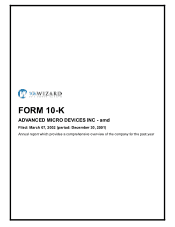AMD 2001 Annual Report Download - page 9
Download and view the complete annual report
Please find page 9 of the 2001 AMD annual report below. You can navigate through the pages in the report by either clicking on the pages listed below, or by using the keyword search tool below to find specific information within the annual report. Many manufacturers of electronic systems are striving to develop new and
increasingly complex products to address rapidly evolving market opportunities.
Achievement of this goal often precludes the use of standard logic ICs and
ASICs. Standard logic ICs generally perform simple functions and cannot be
customized, limiting a manufacturer's ability to adequately tailor an
end-product system. Although ASICs can be manufactured to perform customized
functions, they generally involve relatively high initial design, engineering
and manufacturing costs and significant design risks, and may increase an
end-product's time to market. As a result, ASICs are generally limited to
high-volume products and products for which time to market may be less critical.
A growing category of the full custom IC market is Application Specific
Standard Products (ASSPs). In this category, a full custom design, such as an
Ethernet controller, is used to implement a particular function and is sold to
multiple customers. Because the market requirements for these products have
become increasingly standard, they can achieve the functional advantages of
full custom design with the time to market advantages of a standard product.
Almost all of our networking products are a part of the ASSP category.
Unlike ASICs and standard logic ICs, PLDs are standard products purchased by
system manufacturers in an unprogrammed or blank state. Each system
manufacturer may then program the PLDs to perform a variety of specific logic
functions. Certain PLDs are reprogrammable. Compared to standard logic ICs and
ASICs, PLDs allow system designers to design and implement custom logic more
quickly.
On June 15, 1999, we sold Vantis Corporation, our PLD subsidiary, to Lattice
Semiconductor Corporation. We now function as a foundry to Vantis and plan to
continue to provide services to it through October 2002.
Product Segments
In 2001, we participated in all three technology areas within the digital IC
market--microprocessors, memory circuits and logic circuits--through our Core
Products and Foundry Services segments. Our Core Products segment includes our
PC processors, memory products and other IC products. In 2001, PC processors
included our seventh-generation microprocessors, the AMD Athlon(TM) and AMD
Duron(TM) microprocessors, and our sixth-generation microprocessors. Memory
products included Flash memory devices and EPROM devices. Other IC products
included embedded processors, platform products, which primarily consist of
chipsets, and networking products. Our Foundry Services segment consisted of
service fees from Legerity, Inc., our former voice communication products
subsidiary, and Vantis.
Core Products
Our Core Products segment ($3.8 billion, or 97 percent, of our 2001 net
sales) includes PC processor, memory and other IC products.
PC Processors
In 2001, our most significant microprocessor product sales were from the AMD
Athlon and AMD Duron microprocessors, our seventh-generation microprocessors.
We based AMD Athlon and AMD Duron microprocessors on superscalar RISC
architecture and designed them to be compatible with operating system software
such as Windows XP, Windows 2000, Windows NT(R), Windows 98 (and Windows
predecessor operating systems), Linux, NetWare(R) and UNIX.
We introduced the AMD Athlon XP processor for high-performance desktop
computers in October 2001. The AMD Athlon XP processor features QuantiSpeed(TM)
architecture and 3DNow!(TM) Professional technology. We also announced plans to
drive an initiative to develop a reliable processor performance metric.
Historically, x86 microprocessors have improved both instructions (work) per
clock and frequency compared to older generations. However, this is not true
with some processors today. Therefore, megahertz cannot be solely relied upon
as a measure of system performance. We therefore identify the AMD Athlon XP
processor using model numbers, as opposed to clock speed in megahertz.
5
Source: ADVANCED MICRO DEVIC, 10-K, March 07, 2002






















